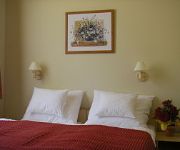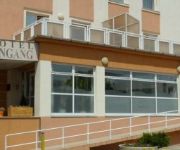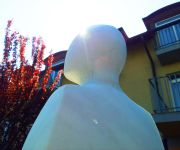Safety Score: 2,8 of 5.0 based on data from 9 authorites. Meaning we advice caution when travelling to Hungary.
Travel warnings are updated daily. Source: Travel Warning Hungary. Last Update: 2024-08-13 08:21:03
Delve into Megyedűlő
The district Megyedűlő of Halásztelek in Pest megye is a district located in Hungary a little south of Budapest, the country's capital town.
In need of a room? We compiled a list of available hotels close to the map centre further down the page.
Since you are here already, you might want to pay a visit to some of the following locations: Szigetszentmiklos, Erd, Budapest, Budakeszi and Martonvasar. To further explore this place, just scroll down and browse the available info.
Local weather forecast
Todays Local Weather Conditions & Forecast: 6°C / 43 °F
| Morning Temperature | 5°C / 40 °F |
| Evening Temperature | 6°C / 42 °F |
| Night Temperature | 3°C / 37 °F |
| Chance of rainfall | 0% |
| Air Humidity | 74% |
| Air Pressure | 1025 hPa |
| Wind Speed | Gentle Breeze with 7 km/h (5 mph) from South-East |
| Cloud Conditions | Overcast clouds, covering 100% of sky |
| General Conditions | Overcast clouds |
Saturday, 16th of November 2024
6°C (43 °F)
3°C (37 °F)
Sky is clear, light breeze, clear sky.
Sunday, 17th of November 2024
5°C (41 °F)
5°C (41 °F)
Scattered clouds, light breeze.
Monday, 18th of November 2024
7°C (45 °F)
4°C (40 °F)
Overcast clouds, moderate breeze.
Hotels and Places to Stay
Holiday Inn BUDAPEST - BUDAÖRS
Belle Fleur
Panderosa Panzio
Training
Hotel Berlin
Luna
Drive Inn former Etap
Videos from this area
These are videos related to the place based on their proximity to this place.
rc Extra300 3D (6mm Depron)
Csak kezdő vagyok a 3D-ben így minden építő jellegű hozzáoszlást/kritikát szívesen veszek!
Tanulj Repülni a legjobb iskolában... FlyTeam.hu Budapest & Szeged
Nagyon látványos reklámfilm Magyarország legnagyobb Repülő-Iskolájáról.
Szökőkutjaink kültéri dekorációs termékeink Kerti-Aruda Halásztelek
Honlapunk: http://www.kerti-aruda.hu Társaságunk műkőből készült vázák, szökőkutak, lámpák, szobrok, figurák, kerti dísztárgyak forgalmazásával foglalkozik. Kert és park...
Videos provided by Youtube are under the copyright of their owners.
Attractions and noteworthy things
Distances are based on the centre of the city/town and sightseeing location. This list contains brief abstracts about monuments, holiday activities, national parcs, museums, organisations and more from the area as well as interesting facts about the region itself. Where available, you'll find the corresponding homepage. Otherwise the related wikipedia article.
Buda
Buda is the western part of the Hungarian capital Budapest on the west bank of the Danube. The name Buda takes its name from the name of Bleda the Hun ruler, whose name is also Buda in Hungarian. Buda comprises about one-third of Budapest's complete territory and is mostly wooded and hilly. Notable landmarks include the Buda Castle and the Citadella. The Hungarian president's residence, Sándor Palace, is also in Buda.
Taksony
Named after the last pagan ruling prince, Taksony of Hungary, Taksony is a village of roughly 6,000 inhabitants roughly 23 kilometers south of Budapest, on the bank of the Ráckeve branch of the Danube known as Kisduna (Little Danube). Taksony is known for its many natural springs and tranquil scenery and serves as a haven for fishermen, boaters and summer vacationers.
Kingdom of Hungary
The Kingdom of Hungary was a multilingual, multiethnic and (as the meaning from the 19th century) multinational country in Central Europe covering what is today Hungary, Slovakia, Transylvania (now part of Romania), Carpathian Ruthenia (now part of Ukraine), Vojvodina (now part of Serbia), Burgenland (now part of Austria), and other smaller territories surrounding present-day Hungary's borders. From 1102 it also included Croatia, being in personal union with it, united under the Hungarian king.
Hungarian Soviet Republic
The Hungarian Soviet Republic or Hungarian Republic of Councils (Hungarian: Magyarországi Tanácsköztársaság or Magyarországi Szocialista Szövetséges Tanácsköztársaság) was a short-lived independent Communist state established in Hungary in the aftermath of World War I. It was the successor of the Hungarian Democratic Republic and lasted only from 21 March until 1 August 1919. The state was led by Béla Kun and was not recognized by France, the U.K. or the U.S.
Lakihegy Tower
The Lakihegy Tower is a 314 metre (1,031 ft) high radio mast at Szigetszentmiklós-Lakihegy. The Blaw-Knox type tower was built in 1933 and was one of Europe's tallest structures at the time of construction. It was designed to provide broadcast coverage for Hungary with a 120 kW transmitter. Developed in the U.S.A. , the diamond shaped mast was specially designed to radiate radio waves in such a way that reduce fading. Thus it was able to serve the whole country.
Csepel
Csepel is the 21st district and a neighbourhood in Budapest, Hungary. Csepel officially became part of Budapest on 1 January 1950.
Csepel Island
Csepel Island is the largest island of the River Danube in Hungary. It is 48 km long; its width is 6–8 km. Its area comprises 257 km². The word Csepel is pronounced CHE-pel. Csepel Island extends south from Budapest; its northern point is Csepel, which is Budapest's District XXI. Most of the island is accessible from Budapest by the suburban railway. Notable towns include Ráckeve, Szigetszentmiklós, Szigethalom and Tököl.
Farkasréti Cemetery
Farkasréti Cemetery or Farkasrét Cemetery is one of the most famous cemeteries in Budapest. It opened in 1894 and is noted for its spectacular sight towards the city (several people wanted it more to be a resort area than a cemetery). It comprises tombs of numerous Hungarian notables and it is the most preferred place for actors and actresses and other artists (opera singers, musicians, painters, sculptors, architects, writers, poets).
Central Hungary
Central Hungary is one of the seven statistical regions in Hungary (NUTS 1 and NUTS 2). It includes Budapest (the capital of the region) and Pest County.
Kelenföld
Kelenföld is a neighborhood in Budapest, Hungary. It belongs to Újbuda, and located in the southern part of Buda. The large Kelenföld housing estate was built between 1967 and 1983 from pre-fabricated concrete blocks. The older streets around Bocskai út were mainly built in the first half of the 20th century. The Kelenföld Railway Station is an important transport hub of Buda.
Sashegy
Sashegy is a hill and neighbourhood in Budapest, Hungary. It is a green, upper middle class area in Buda with expensive family homes. Administratively Sashegy is divided between the 11th and the 12th districts of Budapest.
Diósd
Diósd, Hungary is a small town located between the larger cities of Budapest and Érd in the Budapest metropolitan area, Pest County. It best found by travelling on the road 7 (also known as Balatoni út), which crosses the commune. The motorway M0 runs at the very edge of Diósd. Though many residents commute to work in the capital city of Budapest, the largest employers in the town are a manufacturing plant, named New MGM Zrt.
Hungarian Democratic Republic
The Hungarian People's Republic and Hungarian Republic were short-lived republics that existed, apart from a 133-day interruption, from late 1918 to early 1920. They were established in the wake of the dissolution of the Austro-Hungarian Empire following World War I. During this period, Hungary was forced to cede lands for the formation of nations based on majority-ethnic groups, who formed Czechoslovakia, Romania, and Yugoslavia, made up of Serbians, Croatians and Slovenes.
Kingdom of Hungary (1920–1946)
The Kingdom of Hungary, also known as the Regency, existed from 1920 to 1946 as a de facto country under Regent Miklós Horthy. Horthy officially represented the Hungarian monarchy of Charles IV, Apostolic King of Hungary. Attempts by Charles IV to return to the throne were prevented by threats of war from neighbouring countries and by the lack of support from Horthy. The Kingdom of Hungary under Horthy was an Axis Power during most of World War II.
International Christian School of Budapest
The International Christian School of Budapest (ICSB) is an international school located in Diosd, Hungary. It was started in 1994 as a missionary school.
Budafok
Budafok (German: Promontor; literally "Promontory near Buda, or Buda Point") is a neighbourhood in Budapest, Hungary. It is situated in the southwestern part of Buda, near the Danube, and belongs to District XXII. Budafok was an independent municipality before 1950. The village was known for wine and champagne making.
Majosháza
Majosháza is a village in Pest county, Budapest metropolitan area, Hungary. It has a population of 1,365 (2007).
Szigetcsép
Szigetcsép is a village in Pest county, Hungary. The Csepel Island has two villages Lórév (Lovra) and Szigetscép (Čip) and the town of Ráckeve inhabited by Serbs as well as Hungarians and Germans. In this Hungarian village, approximately one hundred Serbs are living with Hungarians and Germans. The majority of the old Serbian population moved from Szigetcsép to Serbia in 1924 to settle in the village of Bački Brestovac.
Tárnok
Tárnok is a village in Pest county, Hungary.
Memento Park
Memento Park is an open air museum in Budapest, dedicated to monumental statues from Hungary's Communist period (1949–1989). There are statues of Lenin, Marx, and Engels, and several Hungarian Communist leaders. The park was designed by Hungarian architect, Ákos Eleőd, who won the competition announced by the Budapest General Assembly (Fővárosi Közgyűlés) in 1991. Thus the architect: "This park is about dictatorship.
Újbuda
Újbuda (lit. New Buda) is the 11th district of Budapest (Hungarian: Budapest XI. kerület), Hungary. It is the most populous district of Budapest with 137,426 inhabitants (2008). Until the 1890s Újbuda's present territory was a field south to the historical town of Buda. The construction of a new residential area started in the 1900s, the present district was formed in 1930. From 1880 to 1980 Újbuda's population increased from 1180 to 178,960.
Kelenföld railway station
Kelenföld railway station, known as Budapest Kelenföld until 2011, is Budapest's fourth busiest railway station. Opened in 1861, it is situated south-west of the city centre, in Újbuda or District XI in the suburb Kelenföld. Today, Kelenföld is an extremely busy station, with almost all passenger and freight services operated by Hungarian Railways towards Transdanubia passing through.
Lake Feneketlen
Lake Feneketlen (Feneketlen-tó, "Bottomless Lake") is a lake in the 11th district of Budapest, Hungary. The lake was formed in 1877, when clay was removed from the site to supply a brick factory that was situated at nearby Kosztolányi Dezső tér. The lake's water quality in the 1980s began to deteriorate, until a water circulation device was built. The lake today is a popular urban place for fishing.
Gazdagrét
Gazdagrét is a neighbourhood of Budapest, the capital of Hungary. It is located in the western part of the 11th district. It is a residential area consisting of prefabricated buildings with a population of 11,929 (2001 census). The neighbourhood was built between 1983 and 1989, during the last of the Communist-era construction booms, and kept the name the area earned for its rich harvests when it consisted mainly of orchards (Gazdagrét literally means "rich meadow").
Nagytétény Castle
Nagytétény Castle or Száraz-Rudnyánszky Castle is today the furniture museum of the Museum of Applied Arts in Budapest established in 1949. It is located at 9-11 Kastélypark Street in the 22nd District of Budapest.




















![Webcam: Nagytétény: M0 − 10,6 km] M0 − M6 csomópont [M5 felé capture of the webcam Nagytétény: M0 − 10,6 km] M0 − M6 csomópont [M5 felé](https://images.webcams.travel/daylight/preview/1334056451.jpg)